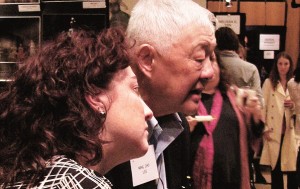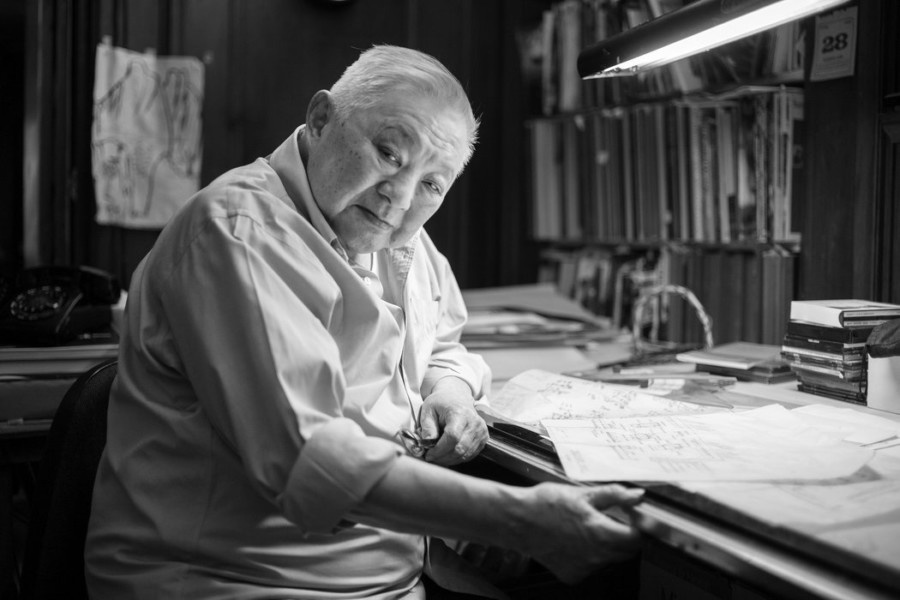The hugely influential theatrical designer and Yale professor Ming Cho Lee died on Oct. 23. He was 90.
Ming Cho Lee: Teacher. Mentor. Friend.
Imagine a sheet of canary yellow tracing paper spread over your work, a No. 2 pencil gently but confidently finding the heartbeat of the design underneath and bringing the intention into focus. It is an image I hold dear as I remember the passion, the love, and the drive of my teacher, Ming Cho Lee.
I can see his hand smoothing the yellow trace on top of my drawing, and I can hear his words guiding his pencil and my eyes as he helps refocus the design beneath. There are so many lessons from that image, even in the choice of materials. The yellow trace torn from a roll is humble, unlike an expensive piece of watercolor paper, which seems to question whether the mark you make is “worth” it. The pencil is quotidian; it makes it easy to toss a sketch aside, tear off another piece of trace, and sketch new thoughts inspired by the first.
The most important lesson, however, was that the trace protected the original design. Ming did not draw on or over my drawing. He was protective. He meant to guide, not to force a change. Deep in his method of teaching was the inspiration that the design for a set is constantly unfolding and that the designer needs to be available to sketch quickly—in model or on a piece of paper—to allow the full idea to be revealed at the end of the process. Ming’s eyes had razor-sharp focus as he weighed scale, proportion, and value in what he was looking at, while also tightening up the point of view of this student designer. He helped me see.
Watching Ming go into action as he was about to critique someone’s design felt like watching a great hunting dog pick up a scent. I saw him work this way hundreds of times, whether it was in the classroom or at the “Clambake,” the annual gathering of graduating MFA designers from across the country. Ming was equally intense from start to finish. Sometimes, as he shifted to your work after exhaustively looking at another designer’s, it felt that you were the prey; but then he would look you in the eye and show his gentle nature and you would breathe. Then his eyes would move to the design in front of him, hungry to leap into a new text and the evolving sketches and model.

The posture was always the same: Eyes at just the right height to see the model from the audience’s eye level. Hands itching to get into the cardboard proscenium so that he could shift something ever so slightly that in full scale might only be a matter of inches, but Ming knew it could bring the whole design into balance. His thirst for looking at theatre work was insatiable. He would stay deeply focused long after other guests or teachers had tired. I realize that it was fuel for him. Oxygen perhaps. Being on the receiving end of a Ming critique was exhausting; sometimes I wasn’t sure I would survive it. So intense. So focused. So much to learn!
Words I would use to describe Ming Cho Lee: Proud. Passionate. Political. He was uncompromising. He loved the challenge and problem-solving of design, and like a chess master was always thrilled with a “beautiful” solution. My favorite moments of observing Ming during a critique were when he would exclaim, “Why didn’t I think of that!” He wasn’t competitive with his students, but he was competitive with himself.
I got my first set design job out of school because of Ming’s “Why didn’t I think of that” response to my thesis design for Uncle Vanya. He was speaking at a TCG conference, where he, in his Ming way, described his excitement about the fact that design is ever-changing and responsive to the times. As an example, he mentioned that a student of his had designed a classic play, Uncle Vanya, in a way he hadn’t envisioned before. An artistic director reached out to him to ask the designer’s name. Ming was so generous that way; I was always grateful for that generosity.
Above all, a breakthrough was the ultimate reward that could come out of a session with Ming. He would prod, cajole, and sometimes demand that you focus your time, energy, and eye to keep searching for the heart of your design. And then, sometimes, a miracle would occur! It was like the moment that the clouds part and the sun bursts through and everything is illuminated. We did learn to see our own work. We did learn to challenge ourselves and our colleagues. Ming helped us to look and to really see.
There is a huge community of theatre artists who have been brought together by Ming and his wife Betsy’s energy. It went way beyond the Clambake. It was in his spirit to reach out and connect us as fellow-minded artists who would then join together and learn from each other. It is that spirit that makes me committed to teaching, to continue to expand the circle and embrace new generations of designers and theatre artists. Ming Cho Lee was a brilliant designer, but it is this commitment to our community that I think of as his legacy. It is a beautiful legacy, and one we must all try to uphold.
Susan Hilferty is an American set and costume designer for theatre, opera, and film.
Go here to purchase a copy of Ming Cho Lee: A Life in Design.


